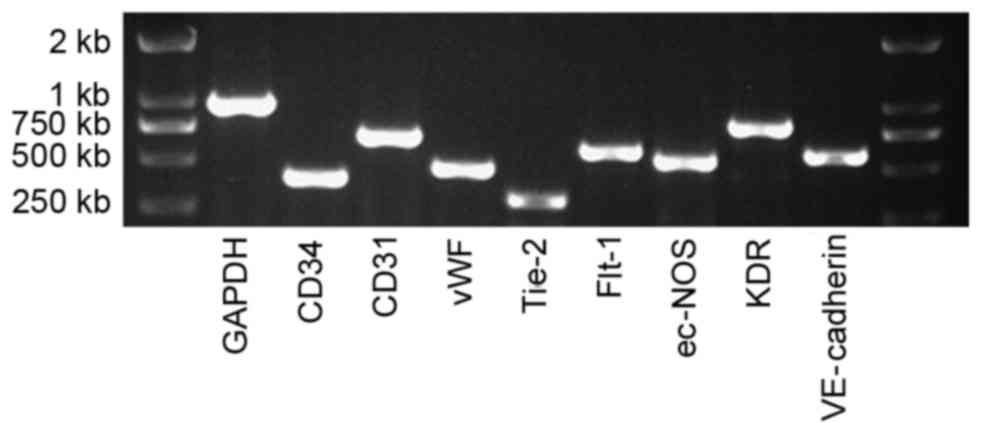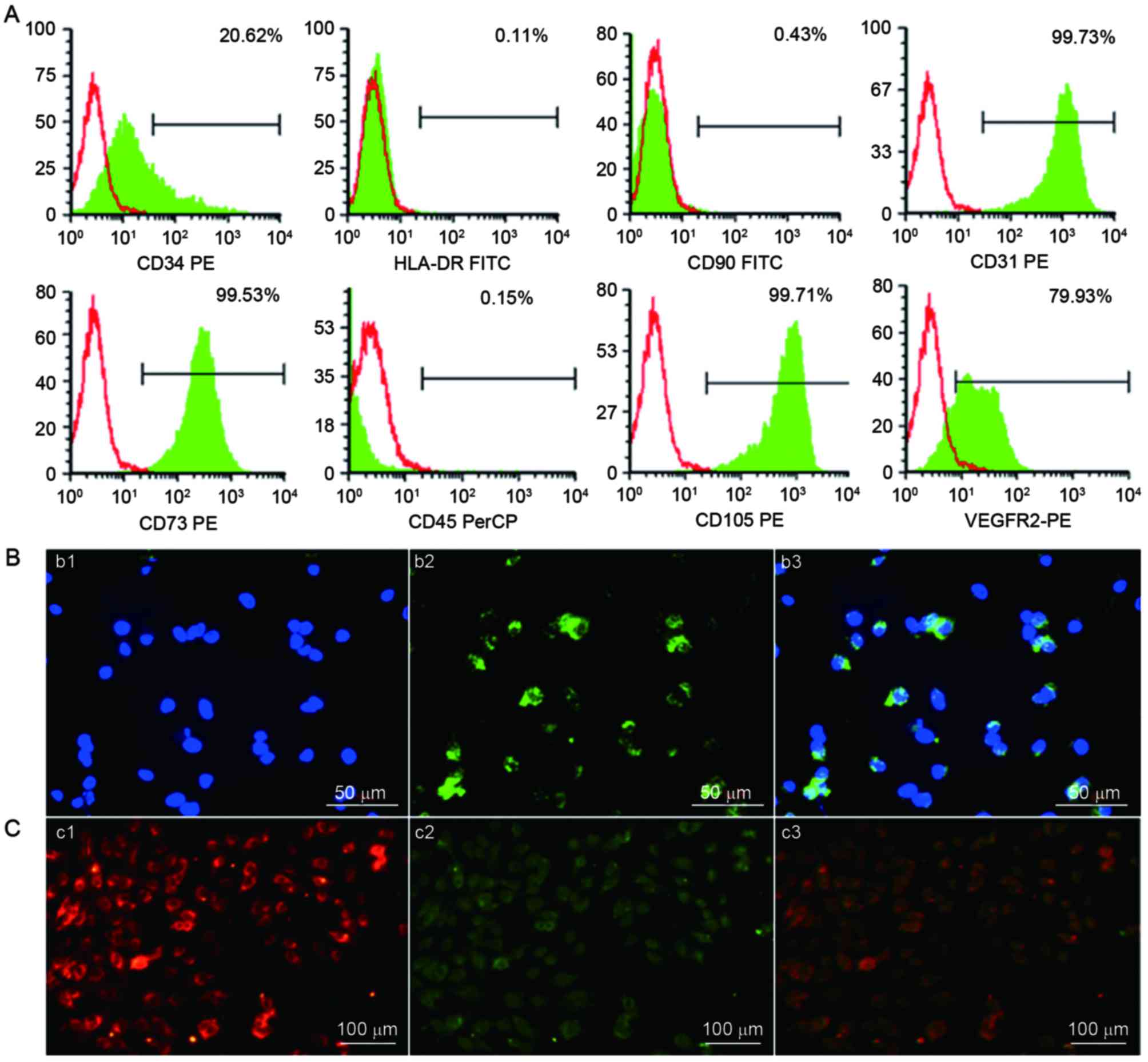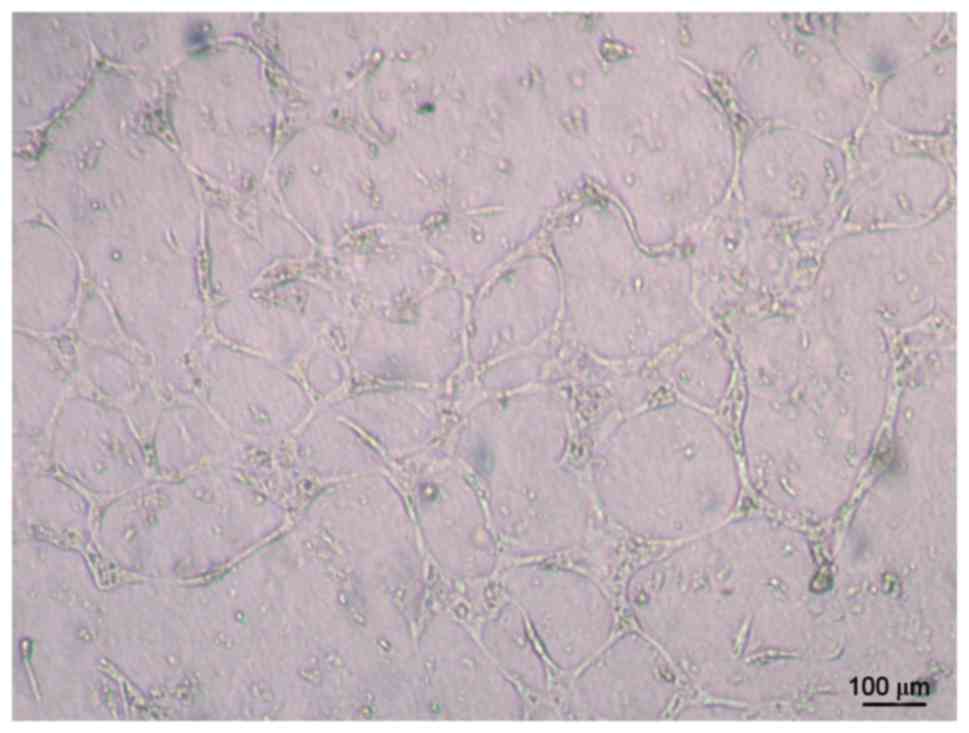|
1
|
Khakoo AY and Finkel T: Endothelial
progenitor cells. Annu Rev Med. 56:79–101. 2005. View Article : Google Scholar : PubMed/NCBI
|
|
2
|
Zwaginga JJ and Doevendans P: Stem
cell-derived angiogenic/vasculogenic cells: Possible therapies for
tissue repair and tissue engineering. Clin Exp Pharmacol Physiol.
30:900–908. 2003. View Article : Google Scholar : PubMed/NCBI
|
|
3
|
Asahara T, Murohara T, Sullivan A, Silver
M, van der Zee R, Li T, Witzenbichler B, Schatteman G and Isner JM:
Isolation of putative progenitor endothelial cells for
angiogenesis. Science. 275:964–967. 1997. View Article : Google Scholar : PubMed/NCBI
|
|
4
|
Ingram DA, Mead LE, Moore DB, Woodard W,
Fenoglio A and Yoder MC: Vessel wall-derived endothelial cells
rapidly proliferate because they contain a complete hierarchy of
endothelial progenitor cells. Blood. 105:2783–2786. 2005.
View Article : Google Scholar : PubMed/NCBI
|
|
5
|
Asahara T, Masuda H, Takahashi T, Kalka C,
Pastore C, Silver M, Kearne M, Magner M and Isner JM: Bone marrow
origin of endothelial progenitor cells responsible for postnatal
vasculogenesis in physiological and pathological
neovascularization. Circ Res. 85:221–228. 1999. View Article : Google Scholar : PubMed/NCBI
|
|
6
|
Lin Y, Weisdorf DJ, Solovey A and Hebbel
RP: Origins of circulating endothelial cells and endothelial
outgrowth from blood. J Clin Invest. 105:71–77. 2000. View Article : Google Scholar : PubMed/NCBI
|
|
7
|
Ahrens I, Domeij H, Topcic D, Haviv I,
Merivirta RM, Agrotis A, Leitner E, Jowett JB, Bode C, Lappas M and
Peter K: Successful in vitro expansion and differentiation of cord
blood derived CD34+ cells into early endothelial
progenitor cells reveals highly differential gene expression. PLoS
One. 6:e232102011. View Article : Google Scholar : PubMed/NCBI
|
|
8
|
Hu CH, Li ZM, DU ZM, Zhang AX, Yang DY and
Wu GF: Human umbilical cord-derived endothelial progenitor cells
promote growth cytokines-mediated neorevascularization in rat
myocardial infarction. Chin Med J (Engl). 122:548–555.
2009.PubMed/NCBI
|
|
9
|
Rapp BM, Saadatzedeh MR, Ofstein RH,
Bhavsar JR, Tempel ZS, Moreno O, Morone P, Booth DA, Traktuev DO,
Dalsing MC, et al: Resident endothelial progenitor cells from human
placenta have greater vasculogenic potential than circulating
endothelial progenitor cells from umbilical cord blood. Cell Med.
2:85–96. 2011. View Article : Google Scholar : PubMed/NCBI
|
|
10
|
Matsumura G, Miyagawa-Tomita S, Shin'oka
T, Ikada Y and Kurosawa H: First evidence that bone marrow cells
contribute to the construction of tissue-engineered vascular
autografts in vivo. Circulation. 108:1729–1734. 2003. View Article : Google Scholar : PubMed/NCBI
|
|
11
|
Kaushal S, Amiel GE, Guleserian KJ,
Shapira OM, Perry T, Sutherland FW, Rabkin E, Moran AM, Schoen FJ,
Atala A, et al: Functional small diameter neovessels created using
endothelial progenitor cells expanded ex vivo. Nat Med.
7:1035–1040. 2001. View Article : Google Scholar : PubMed/NCBI
|
|
12
|
Sun XT, Yuan XW, Zhu HT, Deng ZM, Yu DC,
Zhou X and Ding YT: Endothelial precursor cells promote
angiogenesis in hepatocellular carcinoma. World J Gastroenterol.
18:4925–4933. 2012. View Article : Google Scholar : PubMed/NCBI
|
|
13
|
Scheubel RJ, Zorn H, Silber RE, Kuss O,
Morawietz H, Holtz J and Simm A: Age-dependent depression in
circulating endothelial progenitor cells in patients undergoing
coronary artery bypass grafting. J Am Coll Cardiol. 42:2073–2080.
2003. View Article : Google Scholar : PubMed/NCBI
|
|
14
|
Mandraffino G, Sardo MA, Riggio S,
D'Ascola A, Alibrandi A, Saitta C, Versace A, Castaldo M, Mormina
E, Imbalzano E, et al: Circulating progenitor cells and the
elderly: A seven-year observational study. Exp Gerontol.
47:394–400. 2012. View Article : Google Scholar : PubMed/NCBI
|
|
15
|
O'Brien TA, Tiedemann K and Vowels MR: No
longer a biological waste product: Umbilical cord blood. Med J Aus.
184:407–410. 2006.
|
|
16
|
Tse W and Laughlin MJ: Umbilical cord
blood transplantation: A new alternative option. Hematology Am Soc
Hematol Educ Program. 377–383. 2005.PubMed/NCBI
|
|
17
|
Yoder MC: Endothelial progenitor cell: A
blood cell by many other names may serve similar functions. J Mol
Med (Berl). 91:285–295. 2013. View Article : Google Scholar : PubMed/NCBI
|
|
18
|
Aragona CO, Imbalzano E, Mamone F, Cairo
V, Lo Gullo A, D'Ascola A, Sardo MA, Scuruchi M, Basile G, Saitta A
and Mandraffino G: Endothelial progenitor cells for diagnosis and
prognosis in cardiovascular disease. Stem Cells Int.
2016:80437922016. View Article : Google Scholar : PubMed/NCBI
|
|
19
|
Sidney LE, Branch MJ, Dunphy SE, Dua HS
and Hopkinson A: Concise review: Evidence for CD34 as a common
marker for diverse progenitors. Stem Cells. 32:1380–1389. 2014.
View Article : Google Scholar : PubMed/NCBI
|
|
20
|
Reinisch A and Strunk D: Isolation and
animal serum free expansion of human umbilical cord derived
mesenchymal stromal cells (MSCs) and endothelial colony forming
progenitor cells (ECFCs). J Vis Exp. pii: 1525. 2009. View Article : Google Scholar
|
|
21
|
Zeisberger SM, Zoller S, Riegel M, Chen S,
Krenning G, Harmsen MC, Sachinidis A and Zisch AH: Optimization of
the culturing conditions of human umbilical cord blood-derived
endothelial colony-forming cells under xeno-free conditions
applying a transcriptomic approach. Genes Cells. 15:671–687. 2010.
View Article : Google Scholar : PubMed/NCBI
|
|
22
|
Shintani S, Murohara T, Ikeda H, Ueno T,
Sasaki K, Duan J and Imaizumi T: Augmentation of postnatal
neovascularization with autologous bone marrow transplantation.
Circulation. 103:897–903. 2001. View Article : Google Scholar : PubMed/NCBI
|
|
23
|
Dome B, Timar J, Dobos J, Meszaros L, Raso
E, Paku S, Kenessey I, Ostoros G, Magyar M, Ladanyi A, et al:
Identification and clinical significance of circulating endothelial
progenitor cells in human non-small cell lung cancer. Cancer Res.
66:7341–7347. 2006. View Article : Google Scholar : PubMed/NCBI
|
|
24
|
Resch T, Pircher A, Kähler CM, Pratschke J
and Hilbe W: Endothelial progenitor cells: Current issues on
characterization and challenging clinical applications. Stem Cell
Rev. 8:926–939. 2012. View Article : Google Scholar : PubMed/NCBI
|
|
25
|
Zhang H, Zhang B, Tao Y, Cheng M, Hu J, Xu
M and Chen H: Isolation and characterization of mesenchymal stem
cells from whole human umbilical cord applying a single enzyme
approach. Cell Biochem Funct. 30:643–649. 2012. View Article : Google Scholar : PubMed/NCBI
|
|
26
|
Yoder MC, Mead LE, Prater D, Krier TR,
Mroueh KN, Li F, Krasich R, Temm CJ, Prchal JT and Ingram DA:
Redefining endothelial progenitor cells via clonal analysis and
hematopoietic stem/progenitor cell principals. Blood.
109:1801–1809. 2007. View Article : Google Scholar : PubMed/NCBI
|
|
27
|
Zhao YH, Yuan B, Chen J, Feng DH, Zhao B,
Qin C and Chen YF: Endothelial progenitor cells: Therapeutic
perspective for ischemic stroke. CNS Neurosci Ther. 19:67–75. 2013.
View Article : Google Scholar : PubMed/NCBI
|



















